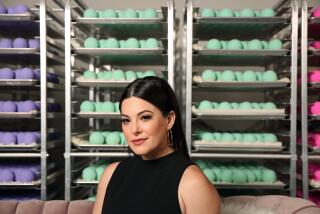Redken’s Founder Takes Back Reins in Attempt to Reverse Downturn
- Share via
If anyone thinks Paula Kent Meehan isn’t a hard-nosed businesswoman, consider the recent goings-on at Redken Laboratories.
The Canoga Park-based hair-care concern has suffered a severe profit slump in recent quarters, and its stock has fallen 26%, from a high of $31.72 1/2 in early 1985, to close at $23.50 Monday. So, in July, the 55-year-old Meehan, Redken’s largest shareholder, decided to shake things up.
Among other things, she demoted her husband.
John E. Meehan, 58, used to be chairman and chief executive. Now he’s chairman and president. Paula Meehan, who retains the title of founder chairman, has taken over as chief executive. Solomon R. Mester resigned as president by what he and Paula Meehan said was mutual agreement.
Paula Meehan, who founded the company 26 years ago and retains a 40% stake, said she took on more responsibility partly because her husband was slowed by triple-bypass heart surgery in March. But “he’s doing great” now, she said, adding that she was also influenced by other factors.
“I didn’t like this fiscal year,” she said.
Earnings Expected to Drop
Indeed, the new chief executive said earnings for the quarter and for the year ended July 31 will be down. In fiscal 1985, Redken posted record earnings of $8.4 million, or $3.05 a share, on sales of $108.5 million.
Several factors appear to be responsible for the downturn.
Mester said profits have been hurt by the high cost of opening Redken’s lavish new laboratory across the street from its headquarters and by snags at the firm’s new factory in Florence, Ky.
Paula Meehan added that the company ran into distribution problems and that she “didn’t feel budgets were tight enough.”
Mester, 52, a cosmetics-industry veteran, said he quit to accept a lucrative consulting arrangement with Redken because Paula Meehan was taking an increasingly active role in the company’s day-to-day affairs. Mester also set up his own consulting business to help U. S. firms penetrate Japan, where he lived for 12 years.
“When she started making a lot of decisions, I started seeing my role diminish,” he said. “I’m not a very good No. 2.”
Actually, Mester already had been the No. 2 executive. When he became president in August, 1984, John Meehan became chairman.
Called Excellent Manager
John Meehan called Mester an excellent manager--”he should be running IBM or General Motors”--but said he lacked some of the personal characteristics needed to head a company like Redken, where the president must take a personal interest in the problems of a single distributor.
Mester left with an agreement to become a consultant to Redken for the three years remaining on his five-year contract, working 10 days a month in the first year and five days a month in the next two years, while continuing to receive his full $216,000 annual salary. Mester also left Redken’s board. No replacement has been announced.
John Meehan used to sell advertising to Redken and joined the company in 1969. Four years later, he married Paula and became company president. Under the new management setup, he oversees sales, domestic operations and legal and personnel matters.
Meehan said she has taken responsibility for finance, marketing, advertising, research and international operations.
Another management change was the resignation of Senior Vice President Armand L. Gauthier, who had been in charge of corporate communications. Paula Meehan said she felt a new direction was needed in the company’s advertising.
“We had to look younger and fresher,” she said.
During February, Redken dismissed 59 workers, including Lee Quaintance, its executive vice president for administration, at least partly to cut costs. The layoffs produced $600,000 in second-quarter severance costs.
Redken also has had to pay for its new, $6-million laboratory, which replaced a facility in Van Nuys that Paula Meehan said was outmoded. She said the laboratory, which is used for tours and ads, has great value in promoting the company’s emphasis on what it calls the science of hair care.
In late March, Redken cut its quarterly cash dividend from 16 cents to 5 cents a share and announced a one-time, 10% stock dividend to partly offset the dividend cut.
Products Sold in Beauty Shops
Distribution was also a problem. The company makes a virtual religion of selling exclusively through beauty salons and stylists, although its products are available, against Redken’s wishes, at some retail outlets. Redken always reached its traditional salon market through a network of independent distributors with longstanding personal contacts among stylists.
But big hair-styling chains are now demanding the right to purchase at distributor prices directly from the company, and Redken has tried to satisfy them without alienating its distributors, a balance Paula Meehan said the company has managed to achieve.
The company’s most serious distribution problem came when it lost its biggest distributor, Armstrong-McCall, an Austin, Tex., concern that accounted for $6 million in annual sales.
Armstrong wouldn’t comment, but Mester said the Texas distributor wanted to expand nationally, which Redken felt would have placed it in competition with existing distributors outside the Lone Star state. In January, Paula Meehan flew to Texas and terminated the distribution agreement personally, Mester said.
Recovered Sales
Redken then set up its own warehouse at a cost of $550,000 and recruited some of the old distributor’s franchisees. Paula Meehan said the company is now close to where it was before losing its Texas distributor.
Vicki Weber, a cosmetics analyst at Merrill Lynch, Pierce, Fenner & Smith, said she wouldn’t be surprised to see Redken’s earnings fall to $3 million for the year that ended July 31, down about 65% from the year before. That would mean Redken’s stock is selling at a hefty 23 times the company’s earnings per share, despite slow growth industrywide in sales to beauty salons.
Weber said the stocks of similar companies generally trade at somewhat more than 13 times anticipated 1987 earnings. Citing Redken’s lofty price-to-earnings multiple, she said, “It would seem that people are expecting earnings to bounce back fairly decently in 1987.”
More to Read
Inside the business of entertainment
The Wide Shot brings you news, analysis and insights on everything from streaming wars to production — and what it all means for the future.
You may occasionally receive promotional content from the Los Angeles Times.










